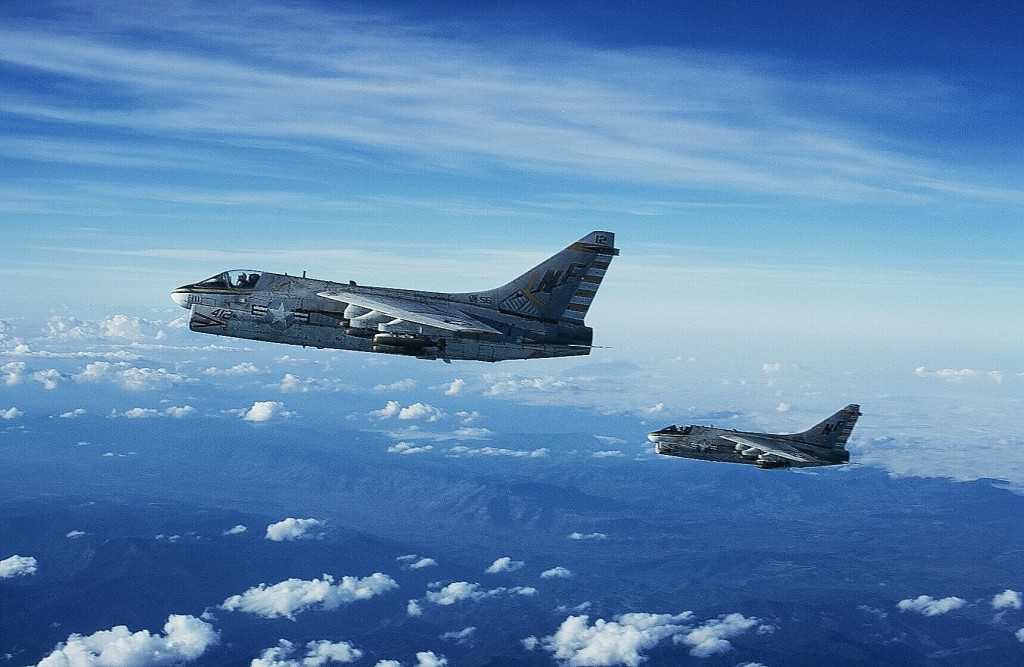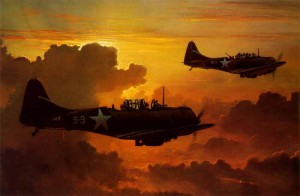Blown Slick Series#5
The A-7 Corsair II carried a healthy fuel load for a carrier based strike aircraft. On major strikes – those to significant, highly defended targets – into North Vietnam called “Alpha Strikes” with 30 -40 A-7,s, A-6’s, F-4’s, bombers, fighters, Iron-Hand MiG Cap, tankers, Electronic Warfare birds and an E-2 control – the A-7’s mostly took off first, landed last. The strike group launched and rendezvoused in a circle above the USS Midway before heading into as we non-PC called it, Indian Country. It took a bit and once

joined on my flight lead, it was both a time of anticipation and building tension, and additionally, a somewhat relaxed reflection period of just waiting. You can take this as gospel or not, but over several dozens of these Alphas in an 11 month cruise, I don’t think I ever did not think and wonder about Pat Patterson in his Dauntless and all those guys doing the same thing – looking out over the partially cloud covered Pacific Ocean – on the 4th of June, 1942 as they launched from Enterprise, Hornet and Yorktown on their way to the most significant naval battle of World War II.
And so today -4 June 2015 – for me “officially” becomes the first remembered sky day.
I have included this in the Blown Slick series because the build up of carrier based airpower – how a/c were designed/tested, the desire always for multi-role a/c, the warfare experimentation (Fleet Battle Problems of the late 1920’s and 30’s) – focused not only on carrier vs. carrier (Japanese build-up assumed) but also on CV survivability and defense, use in defense of islands and power projection, all of which are relatable to today’s airpower issues, no matter the major upgrade in technology.
In a future post, I will describe in more detail the idea of “intersections” to be included over time and how I hope to provide some insight/orientation into an adaptable airpower future in which the F-35 Joint Strike Fighter for the USAF, USN and USMC is indeed the elephant in the room – a force to be reckoned with – flaws, cost, new capabilities, shortfalls and all.
For now, I have provided the final words from Destined for Glory: Dive Bombing, Midway, and the Evolution of Carrier Airpower, by Thomas Wildenberg. A well researched and excellent reference for naval aviation from 1925 through the Battle of Midway June 1942, there are intriguing comparisons for reflection on future airpower. Immediately below are the links to three past postings on this day in history.
-
Morning After Reflection: 5 June 1942 “we sank a carrier”
-
What kind of war was it? – “How do I know, I saw the whole thing backwards!” June 4-7, 1942 at Midway
-
June 4th 1942 – It begins (Preface to Blown Slick -the series: The evolution of fighter, attack, and strike warfare)
Remembered Sky!
***************************************
Chapter 20:
Reassessing Naval Aviation’s Contribution to Victory
Wildenberg, Thomas (2013-04-08).Destined for Glory: Dive Bombing, Midway, and the Evolution of Carrier Airpower. Naval Institute Press.
PRIOR WORKS DISCUSSING the events surrounding the Battle of Midway have largely ignored the importance of the aerial doctrine developed by the navy during the interwar period. With few exceptions, most authors (and perhaps many historians as well) have led the public to believe that the U.S. Navy— outnumbered four carriers to three— was lucky to have won such a decisive victory, given the poor quality of its aircraft relative to that of the enemy.
Though the gods of war certainly smiled upon the navy’s airmen that day, I feel strongly that the demise of the Japanese strike force was a direct result of the navy’s efforts to perfect dive bombing as the central component of its aerial doctrine. The simultaneous arrival of three squadrons of heavily armed dive bombers over Nagumo’s ships when they were most vulnerable was certainly fortuitous, but not unpredictable, given the nature of seaborne flight operations and the U.S. Navy’s insistence that its own carriers launch their strike groups as soon as possible.
Too much emphasis has been placed on naval aviation’s shortcomings in the early months of World War II, particularly with regard to the deficiencies of its torpedo bombers, and not enough on its successes. It is certainly true that the slow, vulnerable TBD-1 Devastator was obsolete, but its successor— the TBF-1— had already entered the pipeline. A few of the new planes even participated in the Battle of Midway, albeit the TBF-1s deployed from Midway’s airstrip fared no better than their elder brethren! 1 The real problem with U.S. torpedo doctrine lay in the inherent vulnerability of these planes in the face of large numbers of enemy fighters— a situation which had not been encountered before, and one which could not be avoided given the limited number of VFs available and the need to throw everything we had at the enemy. The extremely poor performance of the their torpedoes— a fault that can be attributed directly to the Bureau of Ordnance— only ensured that no hits would be achieved by the few VTs that did get through.
Likewise, many have touted the performance of the Mitsubishi A6M5 Zero while ignoring the Grumman F4F-4 Wildcat. Although the latter was somewhat slower and less maneuverable than the Zero, the F4F-4 had better armament and could take much more punishment because of the self-sealing tanks and armor— features that enabled Jimmy Thach and his men to give as good as they received.
Not enough credence is given to the Dauntless SBD dive bomber, an exceptional aircraft that was a generation ahead of its famous rival, the Aichi D3A Val. Its ability to remain
perfectly stable in a dive contributed to the remarkable accuracy obtained by its pilots on that fateful day. These SBDs were armed with a 1,000-lb. bomb fused to go off a fraction of a second after impact so that it would explode just under the flight deck, causing the maximum amount of damage possible with regard to disabling further flight operations.
No one factor determined the outcome of the battle. The navy’s successful effort to break the “Purple Code” of the Imperial Japanese Navy was certainly crucial, as was Nimitz’s decision to take a “calculated risk.” One must not discount the herculean efforts by the Navy Yard at Pearl Harbor to repair Yorktown, either, but only dive bombers and the aerial doctrine under which they were deployed were ultimately responsible for sinking the enemy ships of the Imperial Navy’s First Carrier Strike Force.
Anti-Access/Aerial Denial (A2/AD) is a much discussed topic these days. China’s build up of their Navy and on-going issues and tensions in the South China Sea make both the strategic and tactical response most interesting. The battle of the South China Sea will not be a Midway repeat, but Destined for Glory is well worth a read.






